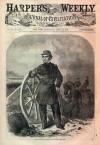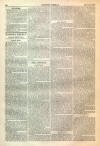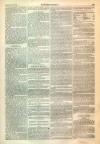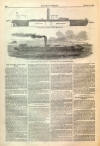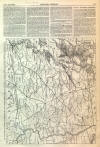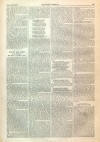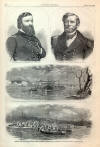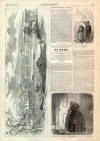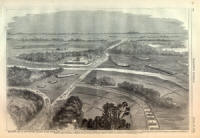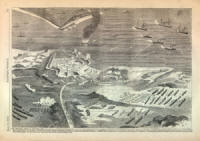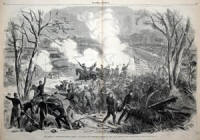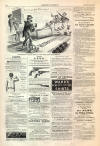Pittsburg Landing Battle
|
|
This Site:
|
APRIL 26, 1862.] HARPER'S WEEKLY. 263 (Previous Page) bank. This wing was under General Hurlburt, and was composed of the Fourteenth, Thirty-second, Forty-fourth, and Fifty-seventh Indiana; Eighth, Eighteenth, and Twenty-first Illinois. [The Fourteenth Indiana Regiment was not there. It is serving under General Shields in Virginia. —ED.] Fronting its line, however, was the Fourteenth, Fifty-seventh, and Seventy-seventh Ohio, and Fifth Ohio Cavalry, of General Sherman's division. For nearly two hours a sheet of fire blazed from both columns, the rebels fighting with a vigor that was only equaled by those contending with them. While the contest raged the hottest the gun-boat Tyler passed up the river to a point opposite the enemy, and poured in broadsides from her immense guns, greatly aiding in forcing the enemy back. Up to three o'clock the battle raged with a fury that defies description. The rebels had found every attempt to break our lines unavailing. They had striven to drive in our main column, and finding that impossible, had turned all their strength upon our left. Foiled in that quarter, they now made another attempt at our centre, and made every effort to rout our forces before the reinforcements, which had been sent for, should come up. At five o'clock there was a short cessation in the fire of the enemy, their lines falling back for nearly half a mile, when they suddenly wheeled and again threw their entire forces upon our left wing, determined to make a final struggle in that quarter; but the gun-boats Tyler and Lexington poured in their shot thick and fast with terrible effect. Meanwhile General Wallace, who had taken a circuitous route from Crump's Landing, appeared suddenly on the enemy's right wing. In the face of this combination of circumstances the rebels felt that their enterprise for the day was a failure, and as night was approaching fell back until they reached an advantageous position somewhat in the rear, yet occupying the main road to Corinth. The gun-boats continued to throw shell after them until out of range. After a wearied watching of several hours of intense anxiety, the advance regiments of General Buell appeared on the opposite bank of the river. The work of passing the river began, the Thirty-sixth Indiana and Sixty-eighth Ohio being the first to cross, followed by the main portions of Generals Nelson and Bruce's divisions. Cheer after cheer greeted their arrival, and they were immediately sent to the advance, where they rested on their arms for the night. All night long steamers were engaged ferrying General Buell's force across, and when daylight broke it was evident the rebels too had been strongly reinforced. The battle on Monday was opened by the rebels at seven o'clock from the Corinth road, and in half an hour extended along the whole line. At nine o'clock the sound of artillery and musketry fully equaled that of the previous day. The enemy was met by our reinforcements and the still unwearied soldiers of the previous day with an energy they certainly could not have expected. It became evident they were avoiding the extreme of our left wing, and endeavoring, with perseverance and determination, to find some weak point by which to turn our force. They left one point but to return to it immediately, and then as suddenly would, by some masterly stroke of generalship, direct a most vigorous attack upon some division where they fancied they would not be expected; but the fire of our lines was as steady as clock-work, and it soon became evident that the enemy considered the task they had undertaken a hopeless one. Further reinforcements now began to arrive, and took position on the right of the main centre under General Wallace. Generals Grant, Buell, McClernand, Nelson, Sherman, and Crittenden were every where present, directing movements for a new stroke on the enemy. Suddenly both wings of our army were turned upon the enemy, with the intention of driving them into an extensive ravine; at the same time a powerful battery, stationed in the open field, poured volley after volley of canister into the rebel ranks. At half past eleven the roar of the battle shook the earth. The Union guns were fired with all the energy that the prospect of the enemy's defeat inspired, while the rebels' fire was not so vigorous, and they evinced a desire to withdraw. They finally fell slowly back, keeping up a fire from their artillery and musketry along their whole column as they retreated. They went in excellent order, battling at every advantageous point, and delivering their fire with considerable effect; but from all the divisions of our lines they were closely pursued, a galling fire being kept upon their rear. The enemy had now been driven beyond our former lines, and were in full retreat for Corinth, pursued by our cavalry. The forces engaged on both sides in this day's battle are estimated at about seventy thousand each—an entire force of one hundred and forty thousand men. Another correspondent, in the same paper, thus mentions the final charge: The enemy, after maintaining their ground till 3 P.M., gave way. The decisive blow was given by General Grant, who headed a charge of six regiments in person, precipitating his whole body on the enemy's centre with such desperate force that they broke and ran. Retreat at once became general. Within half an hour the whole rebel army was falling back in dismay. Our rejoiced soldiers followed them, driving them through our camp in complete disorder. They were soon driven into a broken country, where they would not form or fight. There was no relaxation in the pursuit. At the last accounts the cavalry were eleven miles from the river, still following. The fugitives, exhausted, lay down and waited to be taken prisoners. MAP OF WESTERN TENNESSEE.OUR MAP on this page represents the counties, towns, railroads, main roads, and streams of West Tennessee—the region of the brilliant exploits of the Union army—also the islands, forts, etc., on the Mississippi River from above Island No. 10 to Memphis. New Madrid and Island No. 10 are in the northwest angle of this quadrangular territory; Forts Henry and Donelson in the northeast; Pittsburg Landing and Corinth in the southeast angle. In these corners the national flag flies victorious; while at Memphis, in the southwest angle, the rebel flag hangs listlessly or trembles in the breeze. The surface of this part of Tennessee is even and undulating; most of the streams are sluggish, rising near the Tennessee River, and running westwardly across the country to empty their waters into the Mississippi River. The Big Hatchie River and the South Fork of Forked Deer River are navigable at good stages of water—the former to Bolivar, the latter to Jackson, towns on the Mississippi Central Railroad. The low lands on the banks of the rivers in this region produce gigantic cane-brakes. The soil of the country is a very dark loam, and is productive. The town of Corinth, which the rebels fixed upon for a "stand," is a strong position. It is nearly surrounded by hills, which are the water-shed of streams running to the Tennessee and Mississippi rivers, and the Tombigbee, which flows southward to the Gulf of Mexico. The Mobile and Ohio Railroad, and the Charleston and Memphis Railroad, which cross here, pass through deep cuts of from thirty to seventy feet before entering the town. Huntsville, Alabama, now in possession of the Union forces under General Mitchell, is on the Memphis and Charleston Railroad, about one hundred miles east of Corinth, which is in Mississippi. 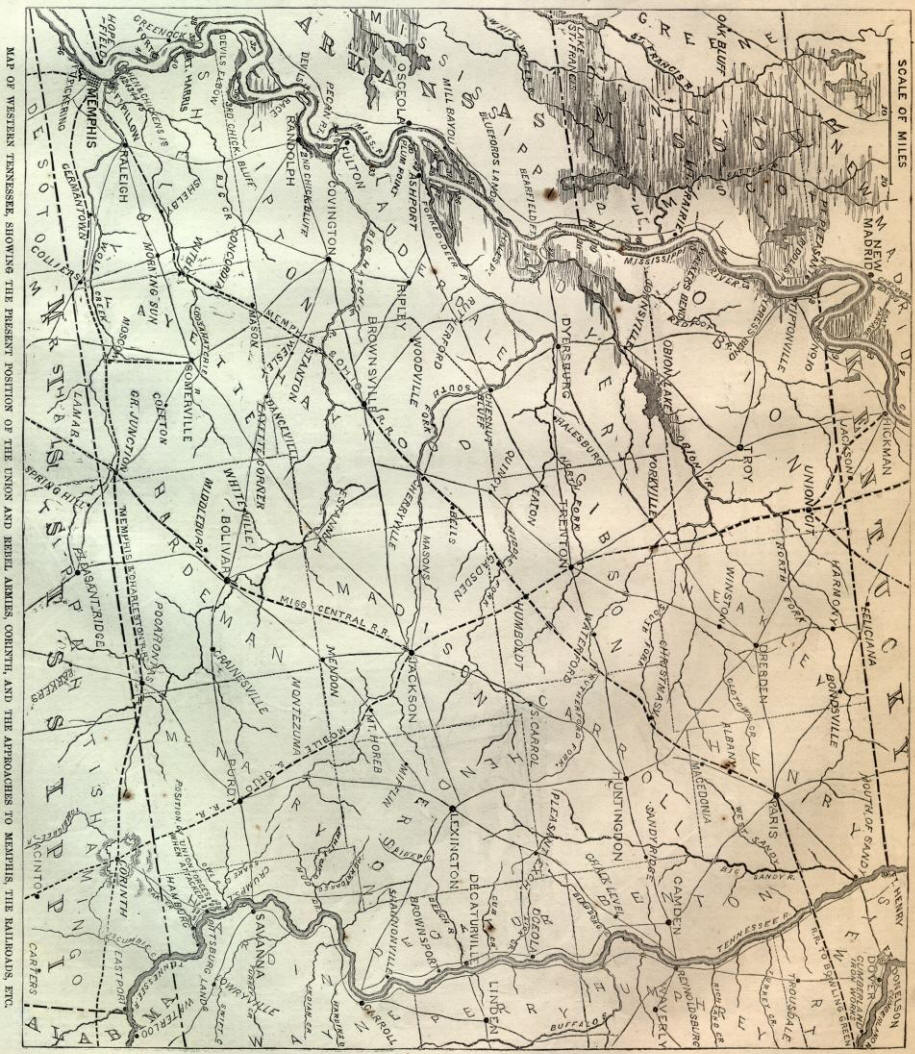 |
||||||||||||||||||||||
|
|
||
|
|
Site Copyright 2003-2018 Son of the South. For Questions or comments about this collection, contact paul@sonofthesouth.net |
|
|
Are you Scared and Confused? Read My Snake Story, a story of hope and encouragement, to help you face your fears. |
||
